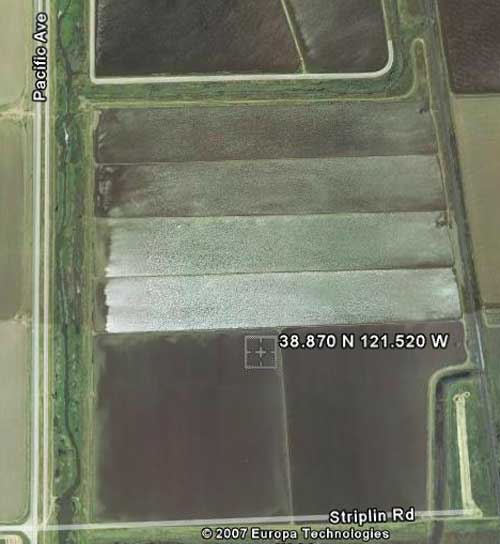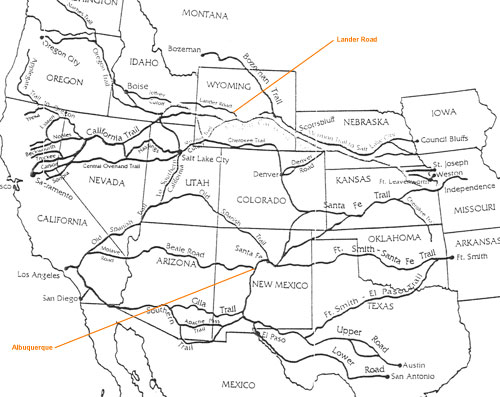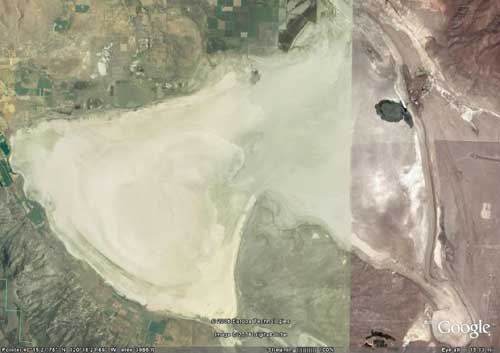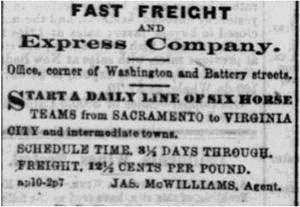|
|
Sam's First Journey West. |
|
Sam first went west before the Civil War,
but his whereabouts during the war are still a mystery.

Our first clues were in his obituary:
He left Hastings in 1858 with an ox team and crossed the plains and mountains to Sacramento, Cal. In 1860 and 1861 he was engaged in "freighting" and in driving a stage coach over the mountains between Sacramento and Austin, Nev.
That he departed from Minnesota, not Shullsburg, Wisconsin, always appeared to be wrong; not so. Evidence indicates Sam did indeed drive freight over the Sierras, but in 1864, not 1861.
And there was this from the Armstrong account:
Sam Belonger, when a boy of 18, walked barefoot with a wagon train across the ground where Denver, Colorado now stands. There were only two cabins then. At one time, about six miles east of where Denver's capitol-building now stands, Sam Belonger and Buffalo Bill Cody, while on a scouting trip, were chased and surrounded by a war party of eight Indians. Their only chance to survive the fight was to shoot their horses and use the bodies for breastworks. Both Uncle Sam and Buffalo Bill, being dead shots with rifles, killed all eight Indians and escaped.
That his wagon train might have gone through Denver also seemed suspect — this was not the route to California. That he should have met a thirteen-year-old Bill Cody there seemed even more of a stretch. Cody was only there briefly, to try his hand at prospecting, but he soon became discouraged and returned to the plains.
Two things we knew for certain: that he voted in Central City, Colorado, in 1861, and that he took title to a piece of land in California in 1865, land recently bought with military scrip by Mormon patriarch Lyman Woods. The plot is Feather River bottom land, about 20 miles north of Sacramento, California.
The land was obtained under the Bounty Land Act of 1855, payment for Woods' service in the Utah Indian Disturbance of 1851-56. This act of Congress promised that all "commissioned, non-commissioned officers, Chaplains, musicians, privates, wagon masters and teamsters of the regular Army, militia and volunteers, as well as all commissioned, non-commissioned officers, seamen, marines, clerks, landsmen of the Navy who had served in any war since 1790 were entitled to 160 acres of land."
But why the transfer? We don't know. Sam must have sold it quickly, as he soon left California for the Midwest. Even after coming west again with Lou, we don't believe he ever lived on the coast again. So did he swindle Woods? Was it repayment for a debt? A favor? Or just business? The stakes of a poker game, perhaps.
These coordinates mark the middle of the square of Sam's claim.
Latitude: 38.870 N
Longitude: 121.520 W

Very flat land, 15 miles north of downtown Sacramento, about 40 feet above sea level. Google Earth shows what may be rice paddies on the north half of the claim. There are levees along the canal and slough that surround the land, meaning that this area was prone to flooding from runoff of the nearby Feather River.
Then Scott came across this on Amazon.com:
Name and Residence: S. H. Blonger, Minnesota
Number of Wagons: 7
Number of Persons: 17
Number of Stock: 129
Destination: California
The listing above comes from a book republished from scans of the original, Additional estimate for Fort Kearney, South Pass, and Honey Lake wagon road. Letter from the acting Secretary of the Interior, transmitting a communication from Colonel Lander in Regard to the Fort Kearney, South Pass, and Honey Lake wagon road. Catchy.
This report to Congress deals more largely with the expedition headed by Col. Lander to inspect and improve the California Trail, and details his mission, which was largely uneventful and an unqualified success. Upon his return, he made a great effort to recommend this route to emigrants as rich in food, water and wood, largely safe from Indian attack, and free from the toll bridges sometimes erected by fur traders in the mountains.

Specifically, the document contains a petition signed by some nine thousand men who had taken the route called the Lander Cutoff, indicating their agreement that a bridge should be built by the government over the Green River in Wyoming, to make the crossing safer for emigrants. They had lost one life, and some property, at this ford.
Sam, apparently, was a party to the petition.
Thirteen thousand emigrants travelled the road the present year; over nine thousand - all the males of the trains - signed papers of which the following are copies:
"We, the undersigned, emigrants to California and Oregon, having just passed with our wagons and stock over the new government road, from the South Pass to Fort Hall, (called Lander's cut-off,) do hereby state that the road is abundantly furnished with good grass, water, and fuel; there is no alkali and no desert as upon the old road, and while upon it our stock improved and rapidly recovered from sickness and lameness. We were much surprised at the great amount of labor that had been done in cutting out the timber and bridging and grading the road, and in all respect it more than met our expectations, especially those of us who have heretofore travelled the other routes. But we would most respectfully suggest that a bridge should be erected, as soon as possible, over Green river, the fording of which is dangerous and the cause of much trouble to the emigration, and in one instance the loss of life. We have been treated kindly, and in every case when the circumstances required it aided and assisted on our way by the Wagon Road Expedition; and we have likewise recieved (sic) the kindest treatment from the Indians; and we advise the overland emigration to California and Oregon to take this road as the shortest and best adapted for the comforts of the traveller and the preservation of stock, especially if the government, in view of the many advantage: of this route, should cause Green river to be bridged."
Signed by Ferguson Chappell and over nine thousand others.
Assuming Sam is an actual signer of the petition, it appears he was with Lander's party on this road, or at least among the thousands who made the trip that summer over the newly improved trail. Sam was still eighteen in the early months of 1858. Perhaps he left Minnesota at that time, but did not cross the plains until 1859. Lander states:
In that [report] of 1859 I related the fact of my stationing a party of men at that [Green] river, equipped with ropes and excellent mule teams, by the aid of which the emigrants crossed it without much difficulty, although some property was lost by them and one individual drowned. At that time the emigrants drew up two petitions asking that this river might be bridged, which, bearing several thousand signatures, in fact, the names of all the male individuals of their trains, were brought by me to Washington and referred to your department.
It is our assumption that Sam's inclusion in this document indicates he signed the petition.
The Lander expedition of 1859 is not well known today, undoubtedly because of its modest success, and lack of tragedy. It is remembered instead for the numerous artworks produced during the trip.
On July 3, 1859, members of the artists, mess awake near Grass Springs in Nebraska Territory. Their covered wagon part of Colonel Frederick Lander's road-building expedition, had halted just east of the Green River, within sight of the Wind River Mountains. Nearby, a crowd of nearly three hundred emigrants shared the same dry piece of sage plain. At least three landscape painters in what Lander called his "full corps of artists" were about to record one of the largest July Fourth celebrations on the plains, augmented by Chief Washakie and eight hundred Shoshone Indians, who would set up in time to share speeches, fireworks, and gifts on this Independence Day eve.
By nightfall, one of the artists noted, "the chief appeared in a United States uniforms, which was presented him by Col. L., and the gaudy costumes of the rest as they danced to the sound of the 'rum-tum,' a sort of tambourine, all together was a magnificent sight to us. At dark we sent up a few sky-rockets, which terrified the Indians so that some of them ran away. They evidently thought we were a great people to send fire up so high."
Here's a beauty by Albert Bierstadt:

The route developed by Lander, called the Lander road or Lander Cutoff, went farther north in Wyoming and Idaho than other routes, avoiding the alkili deserts endured by those traveling to the south. It took longer than other routes, but it was well suited to wagon trains, with their voracious apetities for grass, water and wood.
If indeed Sam traveled this route, he would have started through Council Bluffs, Iowa — near Red Oak, where he and Lou would later set up shop in 1867 — or Missouri, at Independence or St. Joseph, through Ft. Kearney, Nebraska, through Laramie, Wyoming, and South Pass, to Ft. Hall, Idaho, then down along the Humboldt river in Nevada, to Honey Lake, California and finally Sacramento. He may have had call to assist in the development of the road, which was graded in places, bridges built in others. He may have scouted.
Here's Honey Lake today, the western terminus of Lander's responsibility. It's very shallow, I hear, and dries up now and then.

So did he detour to Colorado, and Denver City, to try his luck, then moving on to Sacramento and Virginia City in 1862 — or go all the way to California, with his group, as it seems? Had he gone to Denver first, he would not have occasion to take the Lander Cut Off. Did he rather track back to Denver for a time — then back to California again by the end of the war? Where was he during the war, anyway?
Then came news, via Kenny Vail, that he'd come across two slight but revealing references to Sam, dated 1864 and 1865. To wit:
Reese River Reveille, November 24, 1864
Wadleigh & Wilson's Stage. Arrivals from Virginia - D. Guion, Sam. Blonger, Mr. Shengler.
Reese River Reveille, February 28, 1865
By the Fast Freight - Left for the West. - H. A. Kelly, J. M. Irvine, H. B. Meredith, B. F. Gliddon, S. N. Blonger, Mr. Kamack.
So, Sam rode into Austin from Virginia City -- recent home of reporter Sam Clemens and a young Calamity Jane -- or perhaps from Sacramento, stays three months, then back across the desert and the mountains, and on to his mysterious land deal with Lyman Woods. Not much to go on, and yet...
Foremost, this is our first sighting of Sam in 1864, so that's handy. It may now be safe to assume that he spent part of 1864 in Sacramento and/or Virginia City.
Second, this places him on a damn freight wagon heading into Austin, as suggested by his obit -- though in 1864, rather than '60 or '61. As Kenny Vail said:
I noticed on your website it says Austin boomed in '62. This is not accurate. It really boomed in '63, but was still drawing the sporting fraternity, San Francisco capitalists and Eastern investors well into '64.
Thus, I found the likes of John Bull, Langford Peel, James Earp, Carberry, Spiker and a host of others gunmen not so well know - all there in '64 before Blonger came on the stage. Even Frank Leslie and James Vogan made appearances in '64.
And while we're name dropping:
BTW, Austin was the Holy Hell coming out party for Jimmy Earp, who was about two years younger than Sam. Earp remained there for a total of 13 or 14 months, going to Idaho in fall 1865.
So what was Sam doing? His obit said he drove freight, but these notices aren't explicit on that point. Kenny again:
In regards to the story of Sam driving a stage between Sacramento and Austin, allow me to set a backdrop for his Austin arrival that I found.
There was an alternative in transportation from the big-time Overland Stage & Mail Company, which blew half way across the continent, and then back on a daily basis. West-bound from Austin to Virginia City was a Fast Freight & Express Co. (also passengers) with proprietors Guion, Wadleigh and Wilson. Those were the three names usually advertised. Sometimes it was called "Guion, Wadleigh & Wilson's Stage."
They also ran the same business from Virginia to Sacramento. Daniel Guion was the oldest in the group (Born 1818 in England) and I believe he actually lived in Stockton where his wife and family were set up. I give you the following example because now I am wondering if Sam Blonger was connected with them:
"THE EXPRESS. - The Fast Freight express arrived yesterday evening, bringing a large lot of apples, peaches, new potatoes, cabbage, onions, also a lot of live domestic chickens and pigeons, which can be found for sale at the proprietors of the line, Guion & Wadleigh, on Main street. The express will leave at 8 o'clock this morning for Virginia, connecting with the Fast Freight Lines there." [Reese River Reveille - Aug. 2, 1864]
Sam was travelling with one of the firm's owners. Riding shotgun, maybe? A backup driver? We don't know, but at least we now know where he was.

The Indians
The Lander report has this to say of the Native Americans encountered along the way:
In compliance with your directions to make a brief report of my intercourse with the Indians while in charge of the advance party, I have the honor to say, that after leaving the South Pass we saw only a few lodges of Eastern Sho-sho-nees encamped on Green river. The main body of that tribe were on the eastern slope of the Wind River mountains. Passing from Green river we met none until we reached Soda Springs, where a single Indian came into our camp to trade some beaver skins. He belonged to the Sheepeaters tribe from the headwaters of Lewis Fork, and disclaimed any connection with the Bannocks. He informed me of the departure of the Bannocks for the mountains north of Snake river. It appears that they were afraid of the retaliations of traders or United States soldiers for their depredations committed on Green river and its vicinity last winter.
On the head of Raft creek, near City of Rocks, we were expected and met by Pocotaroh and a party of his band amounting to 15 warriors. He remembered the conditional promise given by you in the fall of 1858 to return the ensuing season and bring some presents.
These Indians appeared destitute, almost, of the necessaries of life, and received with the greatest joy the presents I was directed by you to distribute among them. They were given blankets, cloth, handkerchiefs, knives, paints, and many other trifles, to which I added some flour.
Descending to Goose creek we met several men of the band under the chief Ne-met-teh. They were hunting in the Goose Creek mountains. I tried to engage one of them as guide, but the presence of some companies of the United States army, under the command of Major Lynde, intimidated them so much that they left again for the mountains. The same was the case in Thousand Spring Valley, in the upper part of which we saw several bands of Weber River Indians. On Hot Spring creek about 45 warriors came into the camp; inquired our intentions and those of the soldiers; avowed their honesty; that they had never stolen cattle or robbed emigrants. They received presents and departed without further molesting us, although only 6 persons were in camp at the time, the other members of my party being out on reconnoissance. On the upper part of Humboldt river several lodges were encamped. We saw, nightly, their camp fires 3 or 4 miles from the road at the foot of the mountains. Many of them came into our camp begging and went away fully satisfied with the presents bestowed upon them.
Our interpreter, Alek Frapp, collected, on the north fork of Humboldt river, all the Indians around and brought them, at the request of Major Lynde, just returned from Gravelly Ford, to his camp. Major Lynde made an appropriate speech, and presented them with flour and meat. They informed him that most of their tribe had left the Humboldt and gone south to avoid the passing soldiers.
In our reconnoissance, sometimes extending 70 miles north of the Humboldt, we met only a few lodges of Indians, belonging partly to the Sho-sho-nee and partly to the Bannock tribes. The latter came from the Snake river, where they had passed the fishing season. As they had never seen white men in this part of the country they were at a loss what to make of us, but, as I had always some presents with me, they seemed satisfied with the answer that we were here to see the country.
All the Western Sho-sho-nees have been friendly to us, at least they did not molest us nor attempt to steal our mules. Close to the dividing range between the Western Sho-sho-nees and Pah-Utah tribes, we met about a dozen lodges of the latter Indians. They received presents, but as their language is quite different from that of the Sho-sho-nees, I was unable to learn any thing concerning them. These were the last party of Indians we saw, although delayed for some time in camp at Tutt's Meadows, Humboldt river. I have to recommend to your special notice the good conduct of Isaac Frapp, or Sho-sho-nee Aleck, the Sho-sho-nee half-breed, who has been of great service to the party, both as interpreter and as doing the general work of an employé.
In making these explorations and in carrying out your instructions I have been ably seconded by my assistants, Messrs. Poor, Long, and Key, whom I would recommend to you for favorable mention in your report to the department, and Mr. J. C. Campbell for his valuable general assistance; to John A. Justus, who was more particularly in charge of the transportation, I am largely indebted for the admirable manner in which he performed this important duty. With the exception of the two mules which died, he carried the entire stock through to California in good condition.
I am, sir, with greatest respect, your obedient servant,
WILL. H. WAGNER,
Engineer of Fort Kearney, South Pass,
and Honey Lake Wagon Road.
|



